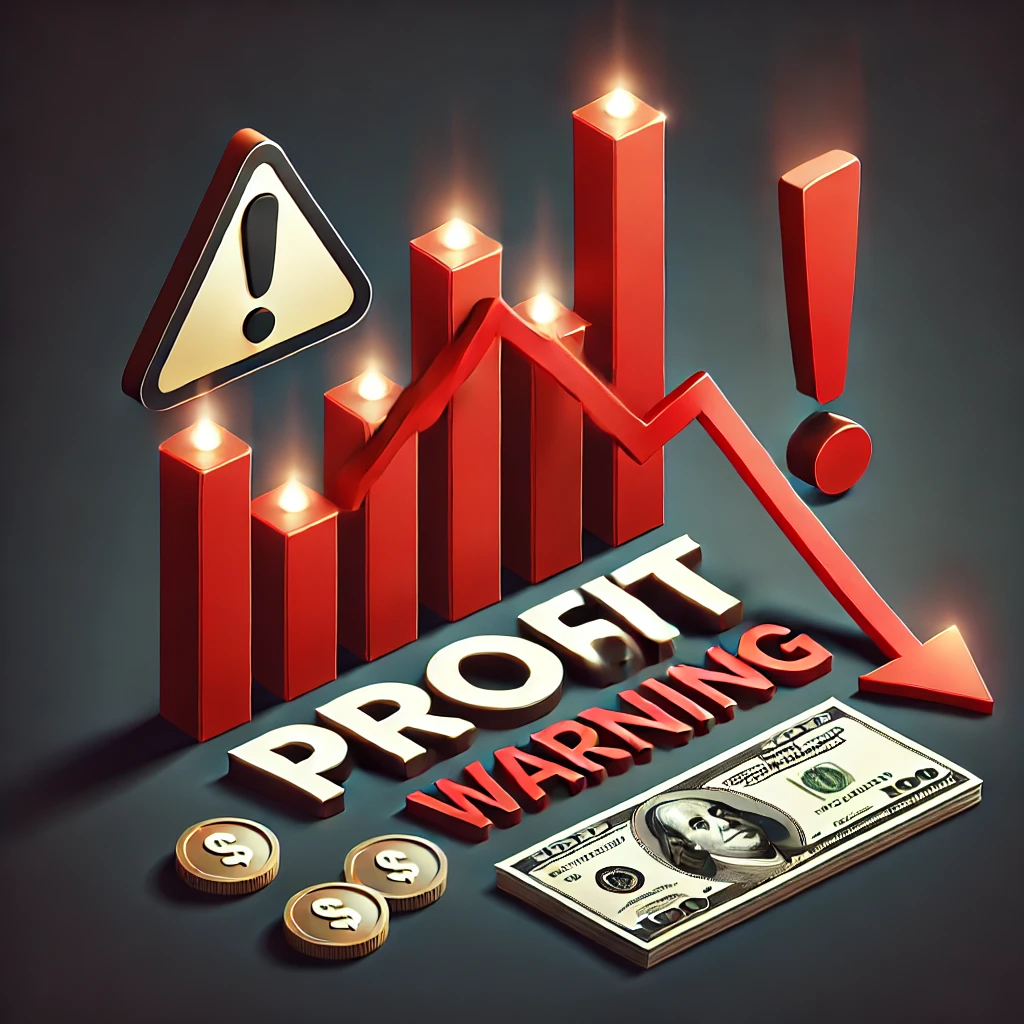
What is a profit warning?
Mike MunayShare
Imagine that a company, after months of growth or stability, suddenly sends out a warning signal. The numbers are not as expected, and what seemed like a good run may be in jeopardy. Investors get nervous, expectations change and the market reacts. That signal, which anticipates turbulence, is crucial for everyone involved to know that something is not going according to plan. Sometimes, it is just a preventive measure; other times, a real red flag.
What is a profit warning ?
A profit warning is basically a warning given by a company when it expects that its earnings will be lower than it had previously forecast. Imagine that a company had promised its investors or the market that it was going to make, say, $100 million in a quarter, but suddenly it realizes that it is only going to make $70 million. So it issues a profit warning to let everyone know that things are not going as well as it had hoped. In technical terms, this happens when earnings projections (known as earnings guidance ) are not met, or when there is an unexpected change in company or market conditions that affects its earnings. This warning is important because it prepares investors for worse-than-estimated financial results.
Which companies can issue a profit warning ?
Any publicly traded company can issue a profit warning . This includes both large multinationals and smaller companies that have shares traded on the public market. It is not common for a private company to do so because it does not have the same pressure to report results to public investors. For example, large companies such as Apple or Tesla, if they anticipate that they will not meet their financial projections, can issue a profit warning . However, it is more common in companies with business models that are highly dependent on the global economy, such as those in the automotive, technology or consumer goods sectors.
Is it mandatory to issue a profit warning ?
It is not mandatory in all countries, but in many major financial markets, such as the United States and the United Kingdom, it is, or at least it is good practice. These regulations exist because publicly traded companies have a responsibility to be transparent with their investors. If a company realizes that it will not meet its earnings expectations, it must inform the market as soon as possible to avoid negative surprises on the day it presents its results.
What are the consequences?
Issuing a profit warning can have several consequences, both for the company and its investors: fall in shares, reputation of the company, management oversight and impact on the sector.
- Most often, after a profit warning, the value of a company's shares falls. Investors get scared when they see that profit expectations will not be met, and they tend to sell their shares, which puts downward pressure on the price. In fact, most often, after a profit warning , the share price can fall by 10% to 20% in the following days.
- Issuing a profit warning can damage a company's reputation. Investors may lose confidence in management or in the company's ability to deliver on its promises. This can make it harder for the company to attract capital in the future.
- The company's management team could face further scrutiny from shareholders and the media. They are expected to explain what went wrong and how they plan to fix the problems.
- In some cases, a profit warning from a large company can affect an entire sector. For example, if a large technology company issues a profit warning , other companies in the same sector could be affected, as investors begin to think that the problems may be general, not just in one company.
If a profit warning brings so many disadvantages, why is it launched?
While issuing a profit warning may seem like a move fraught with downsides, such as falling share prices and loss of confidence, there are several important reasons why a company decides to do so. In fact, it is sometimes the lesser evil compared to other potential consequences. Here's why companies decide to issue one:
Legal and regulatory obligation
In many countries, financial market laws require listed companies to be transparent with investors. If a company knows that it will not meet its earnings expectations, it has an obligation to inform the market. This is because hiding information that affects the share price is considered market abuse.
For example, in the United States, the SEC (Securities and Exchange Commission) requires companies to report any event that may have a material impact on their financial results. If they do not, they risk fines, lawsuits and other legal problems.
In Europe, the Market Abuse Directive also requires transparency when there is a significant change in a company's financial situation.
Transparency and long-term trust
While a profit warning may cause a stock to fall in the short term, transparency can strengthen investor relations in the long term. If a company tries to hide problems, they will sooner or later come to light, and the consequences could be worse.
Issuing a profit warning is a way of saying: “Things are not going well right now, but we are being honest and we are going to work to fix the problem.” Investors, especially institutional ones, value transparency and honesty very much. In some cases, if the problems are fixed, the company can quickly regain trust.
Managing market expectations
A profit warning helps manage investors' expectations before a company releases its results. If a company knows it will not meet forecasts and does not warn the market, the surprise on the day of the results announcement can be even worse. It is better to soften the blow with advance warning than to face a more drastic reaction later.
Such warnings also give analysts time to adjust their forecasts and avoid a market shock. Indeed, if the profit warning is well communicated, some investors may take it as an opportunity to buy shares at lower prices, trusting that the company will improve in the future.
Avoid lawsuits and legal problems
A company that fails to disclose significant financial problems can be sued by shareholders. If the value of the stock drops dramatically because the company was not transparent, shareholders can argue that they were misled and that if they had known the information in time, they would have made different decisions.
For example, in securities fraud cases, companies that fail to issue a profit warning when required could face class action lawsuits from harmed investors. Issuing the warning in a timely manner can help mitigate this risk.
Setting the stage for corrective measures
By issuing a profit warning , the company is also preparing the market for the next steps it may take to correct the situation. This may include restructuring, cost cutting, new strategic plans, or even changes in management. It is a necessary step to explain what is going wrong and how they plan to fix it.
